Milan is the largest city in northern Italy and the capital of the Lombardy region. Only the city of Rome is larger than Milan as well, and its metropolitan area is the 4th-largest in the European Union with over 5.27 million inhabitants.
Apart from being a large city, it’s also the leading city in various fields, including art, commerce, design, education, entertainment, and fashion. This also means that it’s home to some of the most fascinating buildings in Europe.
In this post, we’ll take a closer look at some of the most famous buildings in Milan, amazing architecture that should be on your bucket list of things to visit when you’re in this great city!
1. Milan Cathedral
Milan Cathedral, locally known as the “Duomo di Milano,” is the cathedral church of the city and one of the most amazing buildings in the city.
The construction of this fascinating Gothic cathedral started in the year 1386 and lasted for nearly 6 centuries as the final details of its amazing façade were only completed in the year 1965.
Apart from St. Peter’s Basilica, which is located within the small papal enclave in Rome called Vatican City, it’s the largest church in Italy as well.
Another remarkable fact about the cathedral is that the city was built around it ever since Roman times when the city was called “Mediolanum.”
This means that this location has been the city’s central point for a very long time and the perfect place to start your journey in Milan today.
Official website: Duomo di Milano

2. Sforzesco Castle

Sforzesco Castle, also known as “Castello Sforzesco,” is a remarkable castle in the center of Milan.
It was originally constructed by Francesco Sforza (1401-1466), Duke of Milan, in the 15th century on the ruins of an earlier fortification that dated back to the 14th century.
The castle was seriously expanded in the 16th and 17th centuries and was considered one of the largest citadels in Europe.
It was again rebuilt between 1891 and 1905 and now houses various art collections owned by the city of Milan.
One of the museums inside the building is dedicated to a single work of art known as the Rondanini Pietà. This is a work that Renaissance artist Michelangelo (1475-1564) worked on until the final days of his life.
The most remarkable feature is the central tower called the Torre del Filarete, named after the architect who designed it in 1452.
Official website: Sforzesco Castle

3. Santa Maria delle Grazie
Santa Maria delle Grazie is a great church in Milan with a Dominican convent adjoining it.
This convent is world-famous for having one of the most fascinating paintings on its refectory wall, “The Last Supper,” painted by Leonardo da Vinci.
However, not much of the original painting remains, as it deteriorated quickly because da Vinci used an experimental technique for applying the paint to the wall.
The church was constructed in the 15th century and seriously expanded in the final decade of this century by Duke Ludovico Sforza, the patron of Leonardo.
It’s also assumed that Donato Bramante, the original architect of St. Peter’s Basilica in Rome had a hand in the design of the apse of the church.
Checking out the church that features one of the most iconic murals in the world is a must-do item on your Milan bucket list.
Official website: Santa Maria delle Grazie on Unesco
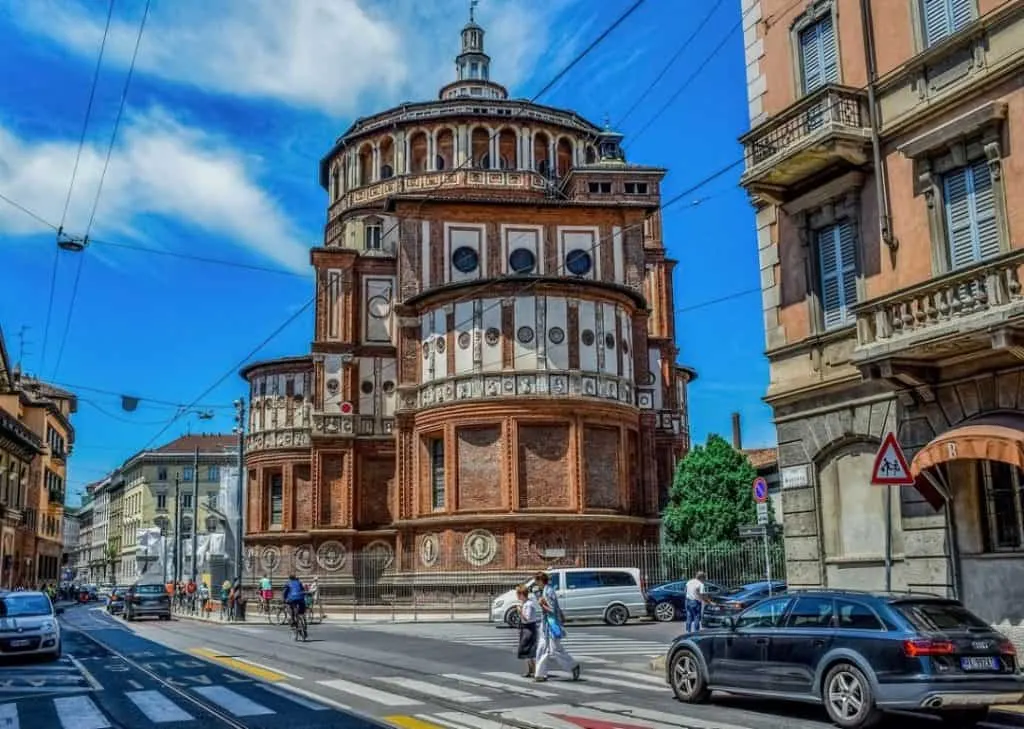
4. San Siro
San Siro is the football stadium of the two rival clubs in the city of Milan, AC Milan and Inter Milan. It’s one of the biggest arenas in Europe, and at the time of writing this list (March 2021), it still stands.
That’s because the local government has approved the plans to demolish this magnificent and iconic sports temple and build a new stadium nearby.
The stadium is officially known as “Stadio Giuseppe Meazza” as it was named after a famous Italian football player who played for both clubs and who won two World Cups with Italy in 1934 and 1938.
He also played for both clubs. The stadium was originally constructed in 1925 and seriously expanded over the following decades.
It’s not demolished yet, so visiting this amazing stadium is still possible today, preferably during a game of one of the Milanese clubs.
Official website: San Siro Stadium
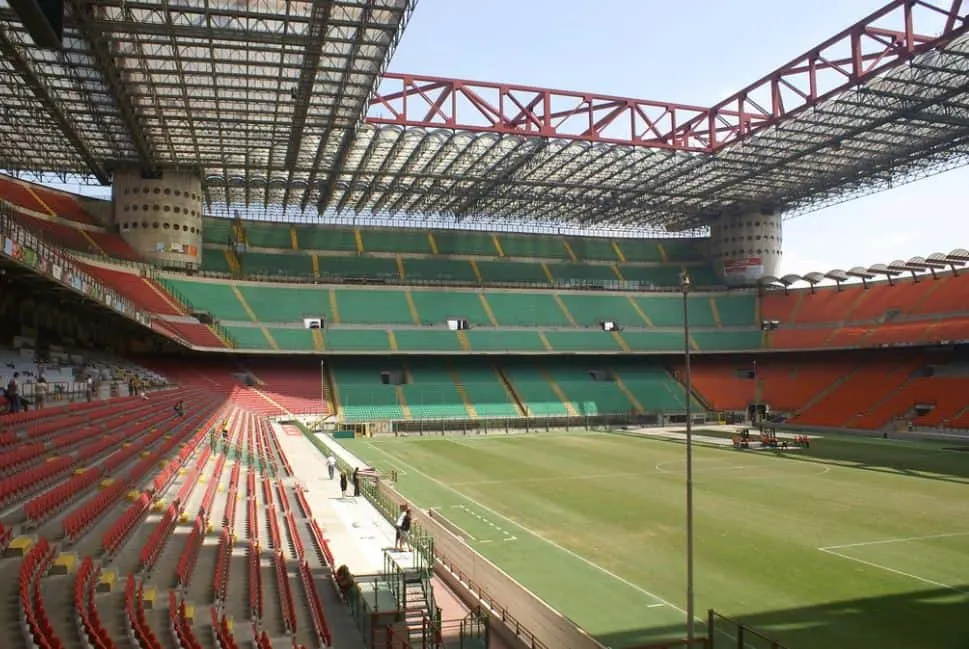
5. Galleria Vittorio Emanuele II
The Galleria Vittorio Emanuele II is the oldest active shopping mall in Italy and is one of the most amazing landmarks in Milan.
It’s located right in the center of the city with one entrance being located on the Piazza del Duomo, the square in front of Milan Cathedral.
The shopping mall was named after King Victor Emmanuel II the first king of a united Italy since the 6th century between 1861 and 1878.
The shopping mall was also built during his reign between 1865 and 1877 and was designed as a four-story double arcade.
This is without a doubt one of the most amazing shopping venues you’ll ever come across.
Not only because of its central location in Milan but also because of the elaborate decorations and architectural features inside the structure.

6. Royal Palace of Milan
The Royal Palace of Milan is another structure just nearby Milan Cathedral and the Galleria Vittorio Emanuele II on the Piazza del Duomo.
It served as the official seat of the government of Italy in the city of Milan for many centuries.
Today, this amazing palace serves as a cultural center and hosts multiple art exhibitions every year with over 1,500 famous works of art on display annually.
Many parts of the Palace were destroyed during World War II and have been restored since, resulting in a fascinating palace for you to visit while you’re in Milan.
If you’re lucky, you might be able to catch a famous art exhibition because this is one of the main purposes of the structure today.
Official website: Palazzo Reale

7. Porta Sempione
Porta Sempione is the name used to describe the city gate of the historical center of Milan.
The main landmark in the area is a magnificent triumphal arch which is called the “Arco della Pace” or the “Arch of Peace,” and which is situated on the “Piazza Sempione.”
Even though this triumphal arch was built in the 19th century and completed in 1838, it was constructed on the location of a gate dating back to Roman times.
A Roman gate was part of the ancient Roman wall that surrounded the city of Milan back then. This kind of demonstrates how much the city has expanded since ancient times.
Like many other neoclassical triumphal arches, it features Corinthian columns, 3 archways, and various bas-reliefs and statues depicting events related to the city’s history.
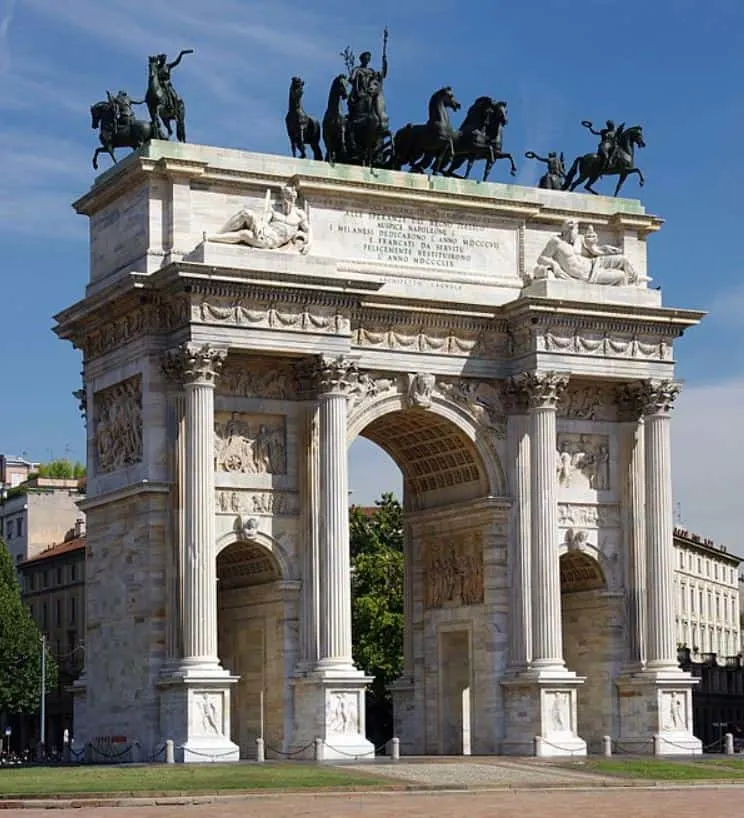
8. Generali Tower
The Generali Tower is one of the most remarkable skyscrapers in the city of Milan, mainly because it has a twisting shape.
Ever since the Turning Torso in Malmö introduced this peculiar form, a lot of towers have followed its example, including this one.
This building was completed in 2017 and stands 191.5 meters (628 feet) tall which makes it the third-tallest building in the city as of March 2021.
It’s the home of “Assicurazioni Generali,” a famous Italian insurance company, and is part of a huge redevelopment program in the center of Milan.
Official website: Generali Tower
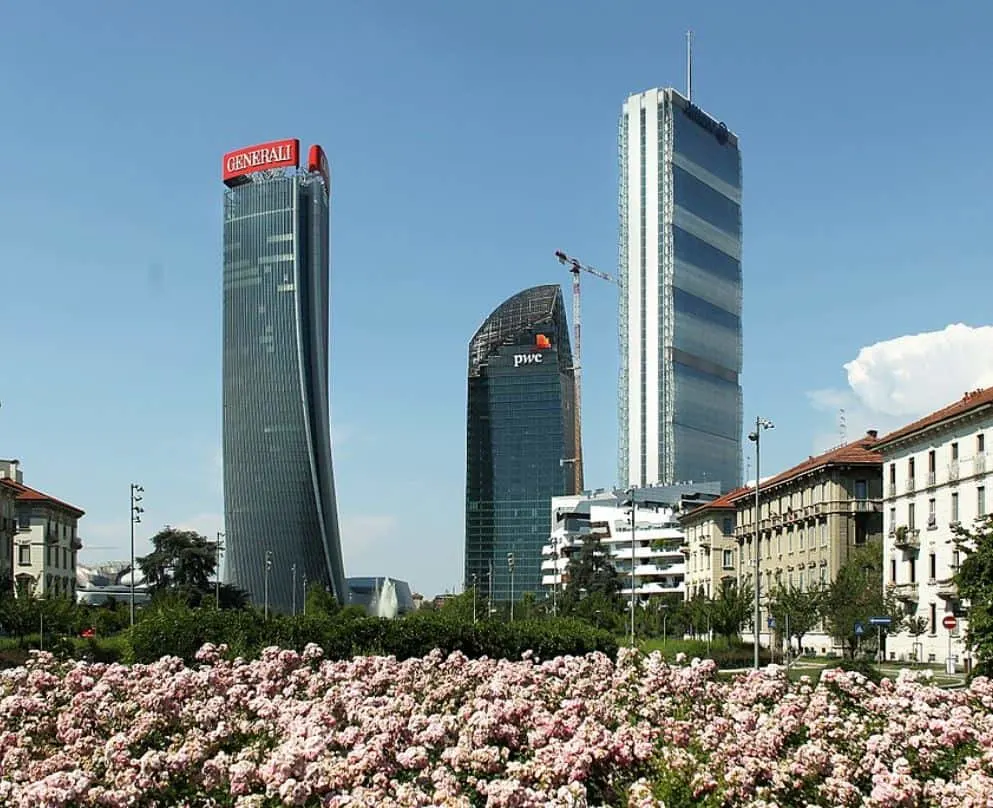
9. La Scala
La Scala is officially known as the “Teatro alla Scala” and is a famous opera house in Milan.
It was originally referred to as the “Nuovo Regio Ducale Teatro alla Scala” upon completion in the year 1778.
Apart from being the venue for the most important opera stars in the world, it’s also used for regular performances of some of the biggest stars in the world and a wide variety of other events.
The building was completely renovated between 2002 and 2004 and is one of the most enthralling venues you’ll ever come across.
Official website: Teatro alla Scala
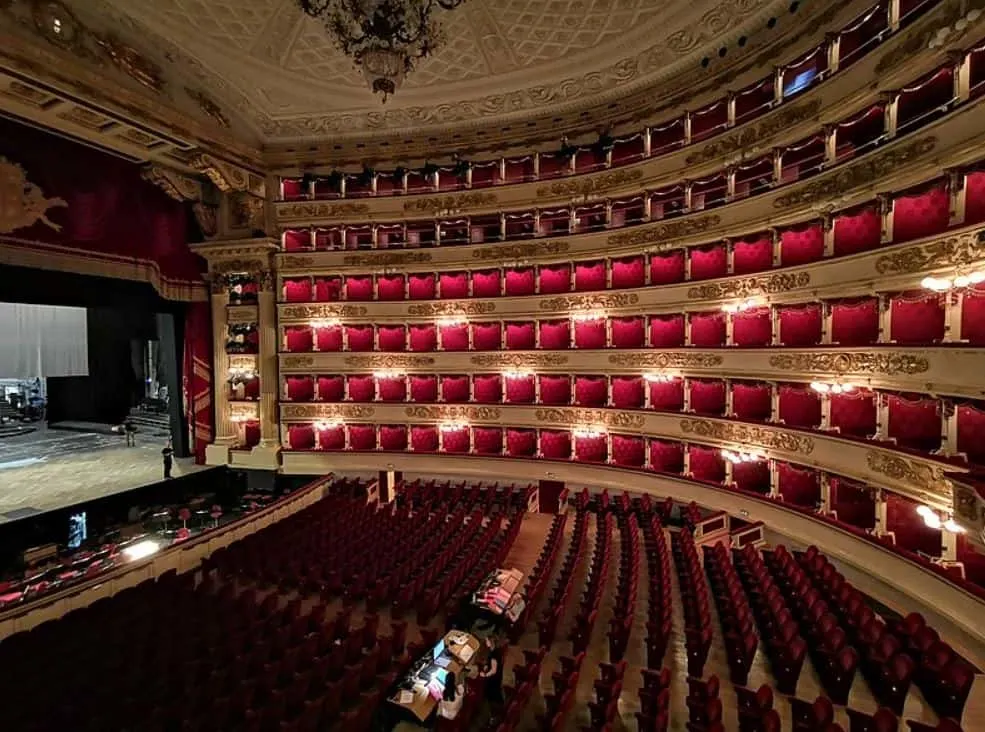
10. Cimitero Monumentale
The Cimitero Monumentale di Milano is the second-largest cemetery in Milan after the Cimitero Maggiore di Milano.
It is, however, the most famous, mainly because it features a wide variety of artistic tombs, monuments, and sculptures.
The cemetery officially opened in the year 1866 and has been filled and decorated ever since with a wide variety of objects and architectural features
These include (but are not limited to) Greek Temples, obelisks, and even a scaled-down version of Trajan’s Column in Rome.
While a cemetery isn’t a common tourist attraction, these remarkable monuments and works of art make walking around here a remarkable experience.
Official website: Cimitero Monumentale

11. Milano Centrale railway station
The Milano Centrale railway station is the city’s most important train station and one of the largest railway stations in Europe by volume.
It’s a terminus station that is situated in the northern part of central Milan but has connections to countless cities in Europe.
Even though the cornerstone of the new central railway station in Milan was laid by King Victor Emmanuel III of Italy on April 28, 1906, the building was only completed in 1931.
The main reason was the economic crisis in Italy caused by World War I.
Milano Centrale is without a doubt one of the most iconic and beautiful railway stations in the world and has become a popular attraction in the city ever since its completion.
Official website: Milano Centrale
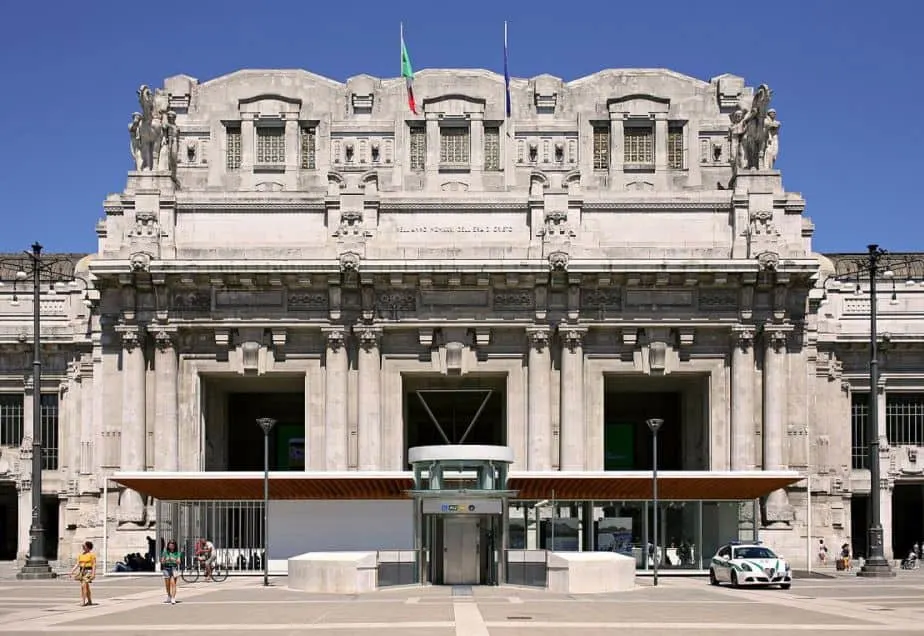
12. Basilica of Sant’Ambrogio
The Basilica of Sant’Ambrogio is a fascinating church in the center of Milan, mainly because it was built on the site of an ancient church that was completed between 379 and 386 A.D.
Back then it was known as the “Basilica Martyrum” because countless martyrs of the Christian persecution by Romans were buried in this area.
Its name was changed in honor of the man who built this original church, Saint Ambrose, who was the Bishop of Milan at the time.
The current building dates back to the 12th century and was completed in the Romanesque architectural style. The highest bell tower was completed in 1144, except for the two highest levels.
This 900-year-old building has been remarkably well-preserved as well.

13. Rotonda della Besana
The Rotonda della Besana is also known as the “Rotonda di Via Besana” and is a large Baroque complex that was constructed between 1695 and 1732.
The original purpose of the complex was to serve as a cemetery for the poor referred to as a “Foppone.”
The main architectural feature is a large colonnade portico in the form of a circle that encloses a garden. In the center of this garden, there’s a church called the church of San Michele ai Sepolcri.
The entire complex near the center of Milan covers an area of 7,100 square meters (76,423 square feet) and is a great place to relax just near the historical heart of the city.

14. San Carlo al Corso
San Carlo al Corso is a fascinating church in the center of Milan that was constructed in the Neoclassical architectural style.
It was completed between 1832 and 1847 to replace a structure dating back to the year 1290.
The original building was a convent founded by the Servite Order, one of the 5 original Catholic mendicant orders.
It was dedicated to Saint Charles Borromeo, the Archbishop of Milan between 1564, and 1584 and to commemorate the end of a cholera plague in the city.
The façade of the church pretty much resembles the portico of the Pantheon in Rome, a former Roman temple that was turned into a Catholic church.
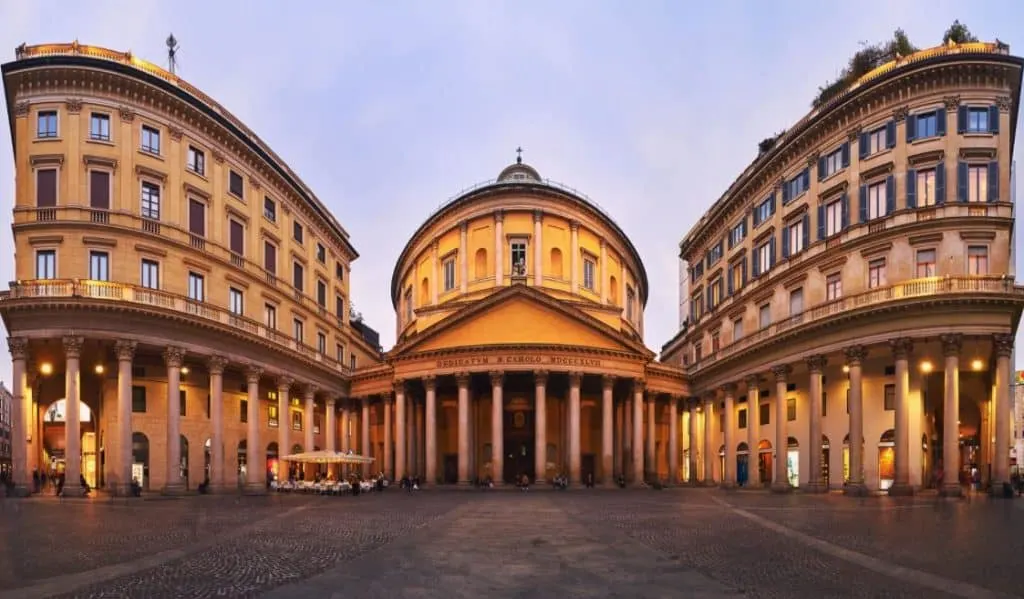
15. Columns of San Lorenzo
The Columns of San Lorenzo are ancient Roman columns located right in front of the Basilica San Lorenzo in central Milan.
The colonnade consists of 16 tall Corinthian columns positioned in a row and they face a public square.
One of the most remarkable facts about this fascinating row of columns is that they were moved here in the 4th century, most probably from a pagan temple that was built 2 centuries earlier.
After all, Christianity became the official religion of the Roman Empire by then.
These ancient columns are quite a sight when you’re walking around in Milan, especially as they only appear to be serving a decorative purpose.

16. Velasca Tower
The Velasca Tower, known locally as the “Torre Velasca,” is one of the first modern skyscrapers built in the city of Milan.
It was built between 1956 and 1958 and has since been one of the most prominent structures of the Milan skyline with its peculiar shape.
The tower is located right in the center of the city and relatively close to the Milan Cathedral.
The tower stands 106 meters (348 feet) tall and was designed in such a way to resemble a modern version of an Italian medieval castle.
The mushroom-shaped structure dominates the historical center of the city as well which doesn’t feature modern skyscrapers.

17. Pinacoteca di Brera
The Pinacoteca di Brera is the main public art gallery in Milan which houses one of the most prominent collections of art in Italy.
The collection originally started as a cultural program of the Brera Academy, a state-run academy of fine arts.
The collection is housed in the Palazzo Brera, a fascinating palace that is also the home of the Brera Academy itself.
The building was originally constructed as a convent of the Jesuits in 1572 but was completely rebuilt between 1627 and 1628 and further expanded in the late 18th century to house the academy.
If you’re into fine art then you’ll surely enjoy works by some of the most renowned artists in history at the gallery. Some of these include works by Raphael, Rubens, van Dyck, and Tintoretto.
Official website: Pinacoteca di Brera

18. Palazzo Litta
The Palazzo Litta is also known as the “Palazzo Arese-Litta” and is one of the most fascinating Baroque palaces in Milan.
It was built during the Spanish rule in the city between 1642 and 1648 after being commissioned by Count Bartolomeo Arese (1590-1674), a prominent member of the House of Arese of the Milan nobility.
While the original version of the palace was completed in 1648, the palace was not finished until the 18th century as the façade of the building was completed between 1752 and 1761.
The palace is now used as an art exhibition center and also features a theater.

19. Leonardo da Vinci’s Vineyard
Leonardo da Vinci’s Vineyard is another mark left on Leonardo’s stay in Milan between 1482 and 1499 where he became the favorite of his patron, Duke Ludovico Sforza, also known as “Il Moro.“
The Duke liked da Vinci so much that he gifted him a vineyard to play around in, and as we all know, he simply had to put it to use to produce the best wine possible.
What’s even more intriguing is that this wine has been reproduced after detailed scientific studies, and we can now drink the same wine da Vinci did over 500 years after the man passed away!
Want to enjoy a glass of one just like Leonardo? Today, you still can!
Official website: Leonardo da Vinci’s Vineyard

20. Casa Campanini
The Casa Campanini is one of the most famous Art Nouveau buildings in Milan.
It’s located on the Via Vincenzo Bellini which is situated just to the east of the city’s historical center.
The building was named after architect Alfredo Campanini, the man who designed it and later lived in it as well.
It was constructed between 1903 and 1906 and one of its most prominent features is the two large concrete caryatids (female sculptures) near the entrance.
This alone makes passing by this remarkable structure worthwhile.

21. Gallia Excelsior Hotel
The Gallia Excelsior Hotel is one of the most fascinating luxury hotels in the city of Milan. It was built in the year 1932 and completely renovated to its former glory between 2010 and 2014.
The hotel is also located on one of the busiest squares in the city called the “Piazza Duca d’Aosta.”
Here you can find the central railway station of Milan and several skyscrapers including the Pirelli Tower.
If you want to spend a night (or multiple) in Milan in style, then this is one of the best places in the city to do so.
Official website: Gallia Excelsior Hotel

22. Santa Maria della Passione
Santa Maria della Passione is a church that was constructed in the Renaissance architectural style and completed in the year 1496 after being commissioned by the Order of Canons Lateran.
The church was expanded several times in its history with the nave being seriously lengthened in the late 16th century.
The most remarkable features of the church are the monumental frescoes painted by Ambrogio Bergognone between 1510 and 1515.
If you want to discover a structure that is considered to be a prime example of Renaissance architecture, then this is pretty much it.

23. UniCredit Tower
The Unicredit Tower is an enormous skyscraper in Milan that was completed between 2009 and 2012.
The tower stands 231 meters (758 feet) tall which makes it not only the tallest building in Milan but in all of Italy as well.
The tower was designed by world-renowned Argentine-American architect César Pelli (1926-2019), best known for designing the Petronas Towers in Kuala Lumpur.
Building this fascinating structure came at an enormous price because the estimated cost by 2015 was about €4.8 billion (US$7.2 billion)!
Even though the sire of the tower is always lit at night, it can be lit in multiple colors for special events as well. This turns this huge structure into one of the most amazing landmarks in the city.
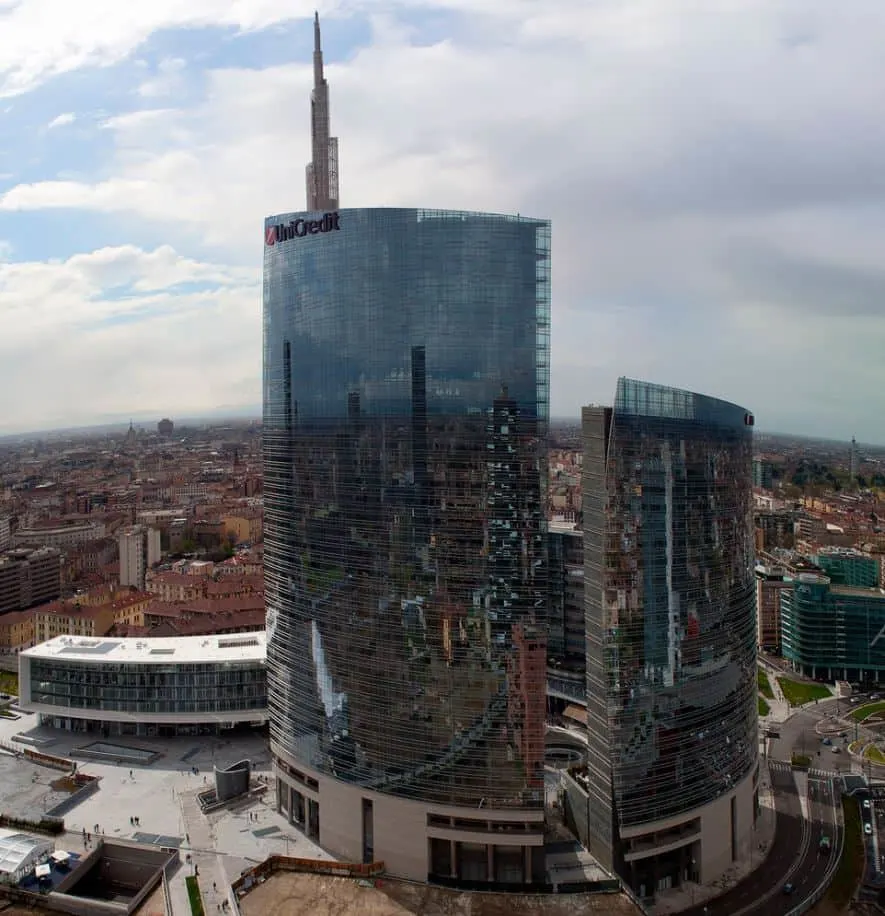
24. Sempione Park
Parco Sempione is one of the largest city parks in Milan and covers an area of about 38.6 hectares (95 acres).
It’s also situated right in the historical center of the city, making it a great place to relax while visiting the most famous landmarks in Milan.
The park adjoins the gardens of the Castello Sforzesco and is bordered by the monumental triumphal arch called the “Arch of Peace.”
Other famous buildings in the park are the “Arena Civica,” a stadium that first opened its doors in the year 1807, and the Civic Aquarium of Milan.
You’ll hardly find a better place to relax during your stay in Milan than in this vast public piece of nature, that’s for sure.

25. Branca Tower
The Branca Tower, known locally as the “Torre Branca,” is an iron observation tower located within the Parco Sempione.
The tower was originally built during the fascist era in 1933 in honor of the 5th edition of the Milan Triennial.
The tower stands 108.6 meters (356.29 feet) high and is open to the public.
Because of its central position in the city, it’s one of the best spots in the city to get an amazing view of Milan and its surroundings!
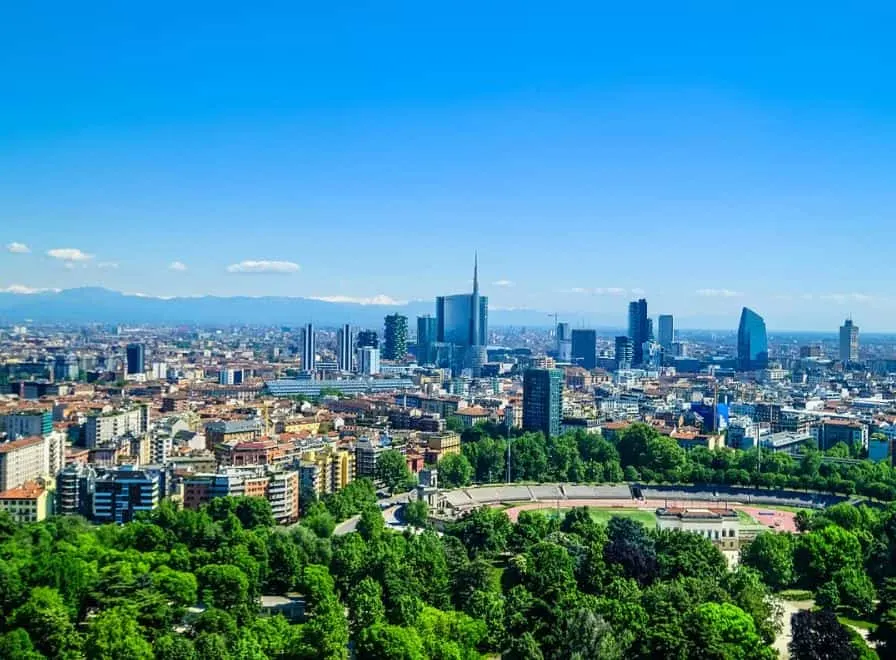
26. Triennale di Milano
One of the major structures inside the Parco Sempione is called the Palazzo dell’Arte, a building constructed between 1931 and 1933.
It was originally designed to become the venue of a popular international art and design exhibition called the “Milan Triennial.”
It served this purpose a total of 14 times between 1936 and 2016 but was transformed into a permanent art and design museum with the same name in 2007.
The museum is adjoined by a popular theater known as “Teatro dell’Arte,” which is housed in the same building.
The museum features a wide variety of design objects along with exhibits related to architecture, and the visual, scenic, and performing arts.
Official website: Triennale di Milano

27. Bosco Verticale
While the UniCredit Tower is a marvelous modern structure, just a short distance further you can admire 2 towers that might give a glimpse of what the future will look like.
These towers are known as the “Bosco Verticale” and while they only stand 111 meters (364 feet) and 76 meters (249 feet) tall, they feature over 900 trees.
These were planted on specially designed terraces that cover a total area of 8,900 square meters (96,000 square feet), resulting in an amazing sight, to say the least.
But that’s not all!
The trees are adjoined by 5,000 shrubs and 11,000 perennial plants of over 90 different species. Because of the presence of this vertical piece of nature, it’s expected that new birds and insects will come to the city as well.
The trees and plants not only protect the building from the heat in the summer and cold winds in the winter but also from dust and noise pollution coming from the streets below.
Could this be the landscape of the city landscape of the future? It very well might be.
Official website: Bosco Verticale

28. Church of St. Maurice
In a city that is home to the Last Supper painting, it’s hard to compete for murals to be better. Remarkably, the murals at this particular church can hold a candle to Leonardo’s masterpiece.
San Maurizio al Monastero Maggiore is a church in the heart of the city that was originally part of the largest female Benedictine monastery in the city known as “Monastero Maggiore.”
The church was completed between 1503 and 1518 and even though the exterior looks rather dull, a common feature of churches built during the renaissance in Italy, the interior is magnificently decorated.
The 16th-century frescoes decorating the interior of the church depict various religious scenes and cover just about every part of it.
To make things even more intriguing, this magnificent structure is today also used as a concert venue, quite an amazing place to enjoy music, don’t you think?
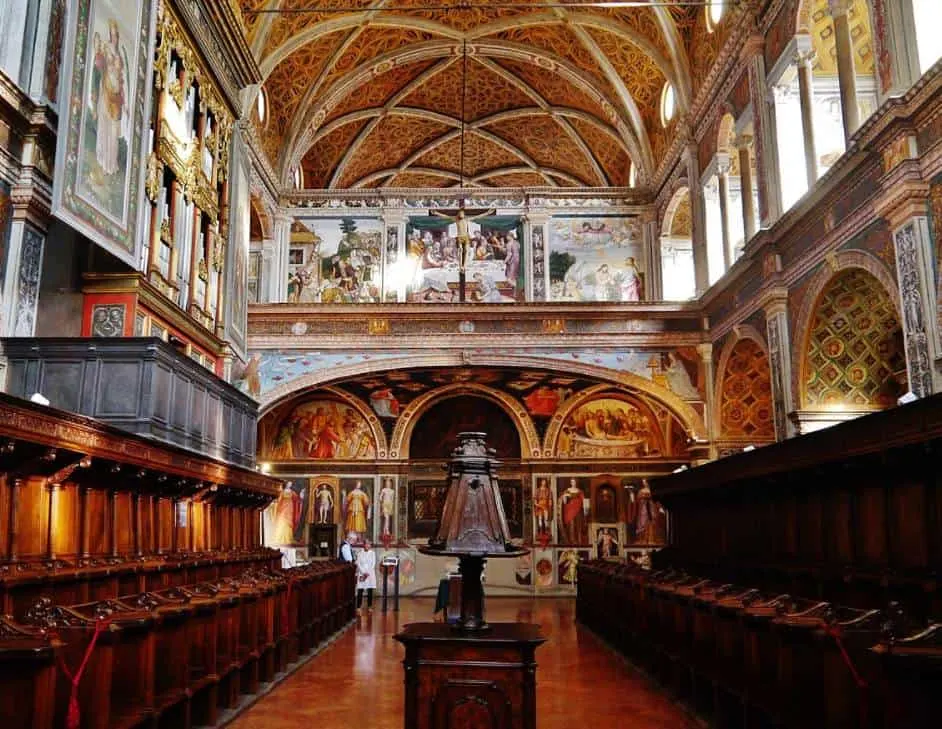
29. Ambrosian Library
The Ambrosian Library was originally founded in 1609 and features a historic library, an academy, and an art gallery with fine artworks. It was named after Ambrosius, the patron saint of Milan.
The library is filled to the brim with historic manuscripts, including 12 manuscripts by Leonardo da Vinci.
One of these is the “Codex Atlanticus,” a manuscript consisting of 12 volumes of drawings and scribblings by the renaissance polymath.
The art gallery has some interesting paintings on display as well, including masterpieces such as Leonardo’s “Portrait of a Musician“, Caravaggio’s “Basket of Fruit,” and a cartoon made by Raphael of his epic fresco “The School of Athens.”
This should be enough for any art lover to visit this remarkable place in the heart of Milan.
Official website: Biblioteca Ambrosiana
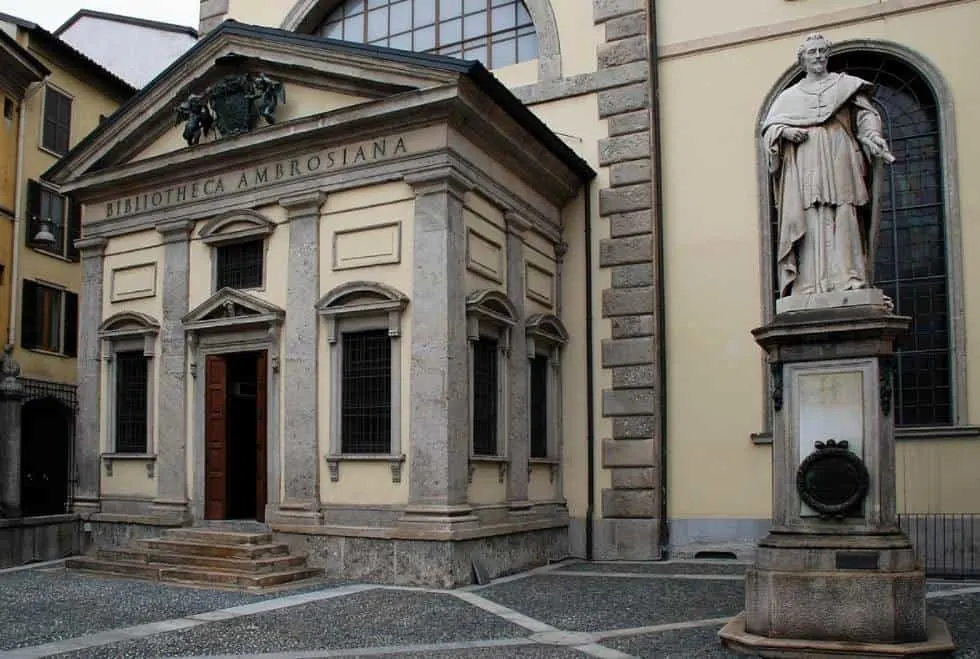
30. Via Monte Napoleone
Since Milan is considered to be the fashion capital of the world, it’s only normal that there are plenty of opportunities to shop here.
We already mentioned the Galleria Vittorio Emanuele II, a historic shopping mall in the heart of the city, but there are a whole lot more shopping opportunities in the city.
The main shopping street in the Quadrilatero della Moda, the upscale shopping district in the city, is called the Via Monte Napoleone.
Don’t get too excited though, because this is considered to be the third most expensive shopping street in Europe.
This means that you’ll only find fashion and jewelry stores of high-end fashion designers here, including Prada, Gucci, and multiple equally renowned brands.
More of the buildings in the street was rebuilt in the neoclassical architectural style in the early 19th century. These palaces served as the residences of aristocratic families.
If you don’t have the cash ready to buy high-end merchandise, admiring these remarkable buildings in Milan is reason enough to visit this street.
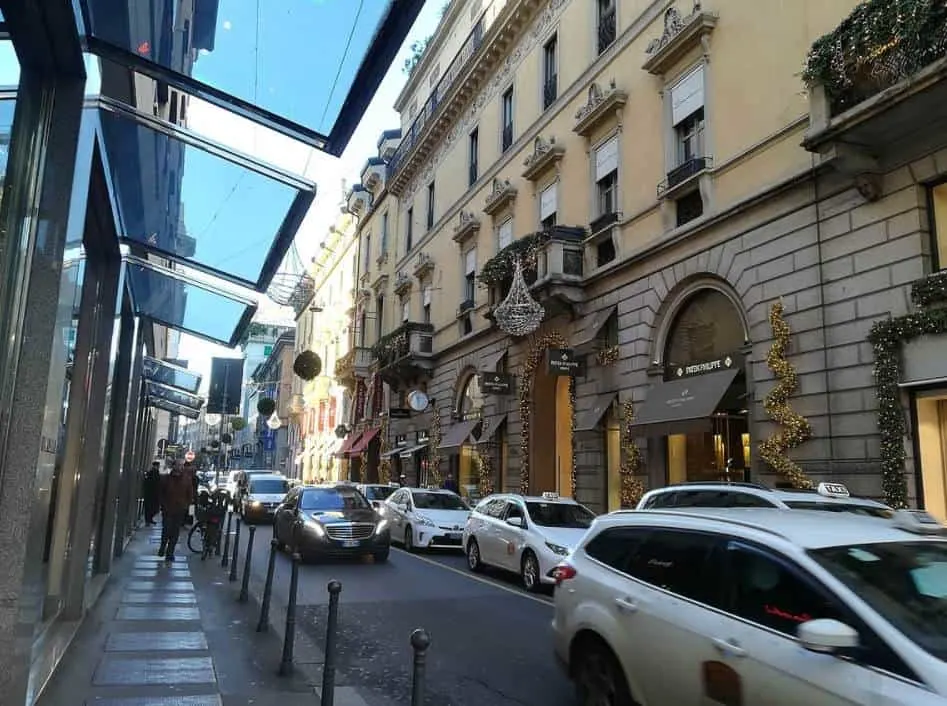
31. Galleria d’Arte Moderna
As the name of the museum implies, the Galleria d’Arte Moderna is a museum solely focusing on modern art.
It’s housed in the magnificent Villa Belgiojoso Bonaparte, also known as the “Villa Reale,” which is located near the eastern gate of the city known as the Porta Venezia.
This neoclassical palace was built during the French Revolution between 1790 and 1796 and was named after the Austrian Diplomat who built it.
The museum was established in the year 1921 and features a great collection of works dating back to the 19th and 20th centuries.
Some of these include works by Antonio Canova, Vincent van Gogh, Édouard Manet, Paul Gauguin, Paul Cézanne, and Pablo Picasso.
Official website: Galleria d’Arte Moderna
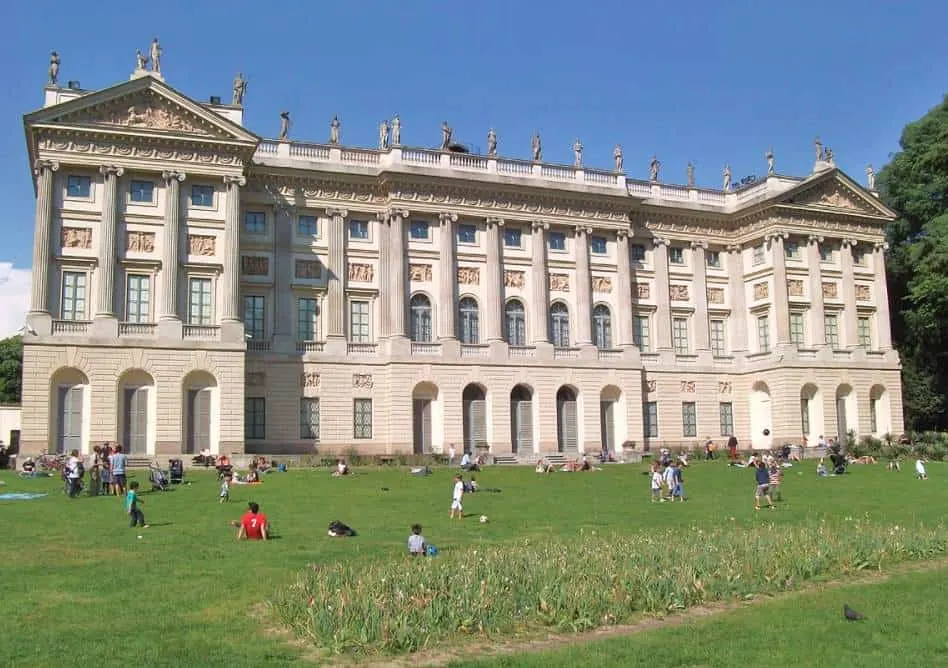
The word “Navigli” describes an interconnected web of canals that were built in and around Milan. The most important of these is known as the “Naviglio Grande.”
The origin of this canal can be traced back to the year 1157 as this is the year that an original ditch was dug. This was considered to be one of the greatest engineering projects during the Middle Ages.
Today, the canal is lined with restaurants and bars and has become one of the most prominent nightlife centers in the city.
Strolling along this canal is great at night because this area comes to life after sunset.
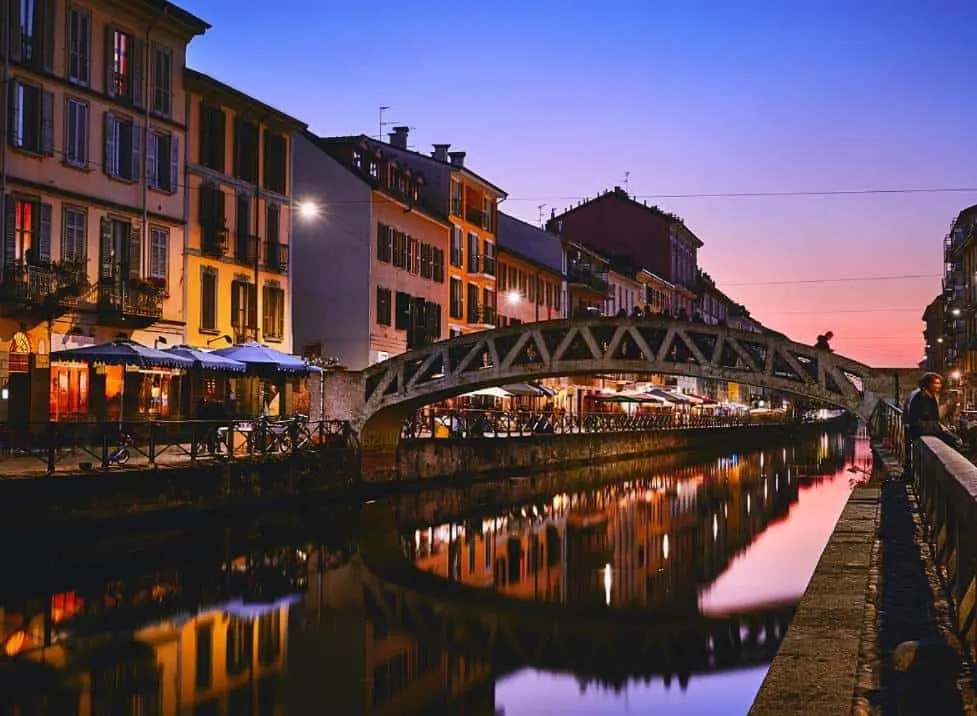
33. Archaeological Museum
The main archaeological museum in Milan is known locally as the “Civico Museo Archeologico di Milano” and is housed in the Monastero Maggiore.
Yes, this monastery is nestled against the San Maurizio al Monastero Maggiore church which features those amazing religious murals.
The artifacts in this fascinating museum date back to the time that the city was called Mediolanum, the ancient predecessor of Milan that was founded in the 4th century B.C.
Mediolanum eventually ended up being conquered by the ancient Romans in 222 B.C. and became the capital of the Western Roman Empire. This happened during the reign of Emperor Maximian in the late 3rd century A.D.
The items on display can be traced back to this period and include statues, tombs, vases, and helmets used during ancient battles.
The museum is located right where the ancient Roman wall around Milan was located and includes a remarkably well-preserved ancient Roman tower as well.
Official website: Civico Museo Archeologico di Milano
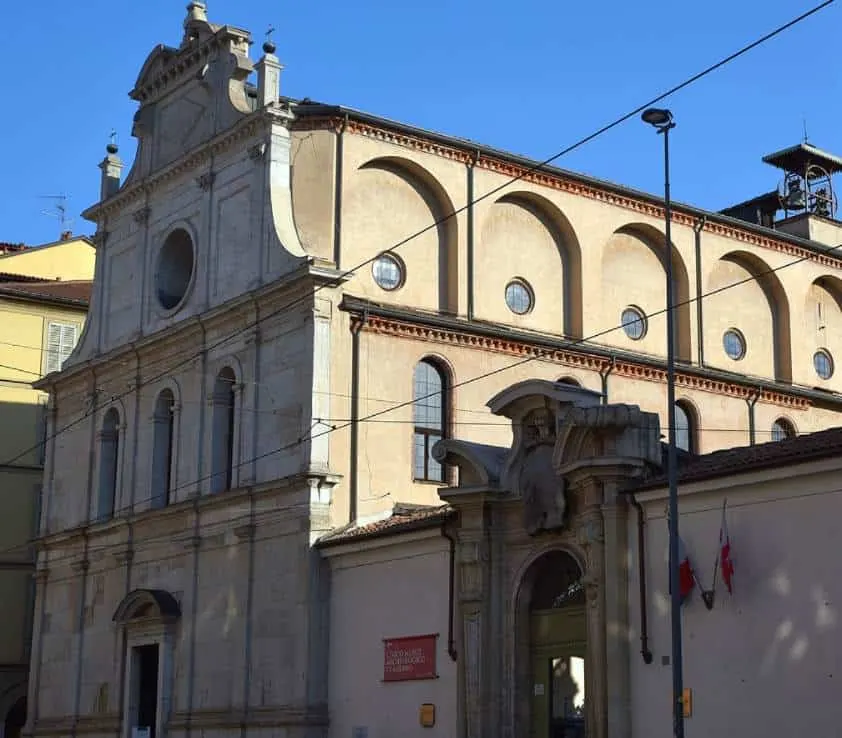
34. Brera Botanical Garden
Just walking distance north of the city’s historical center you can find an amazing piece of nature known as the Brera Botanical Garden, locally known as the “Orto Botanico di Brera.”
It’s located just next to the monumental Brera Palace after which it was named and was established way back in 1774. This happened on orders of Maria Theresa of Austria to grow medicinal plants.
The most fascinating attraction in the garden is a Ginkgo biloba tree, also known as a “maidenhair tree,” which is considered to be one of the oldest in Europe.
The garden is managed and maintained by a department of the University of Milan and is free to visit every weekday.
The greenery brings a sense of tranquility to the crowded city, so that alone makes it worthwhile to visit.
Official website: Brera Botanical Garden
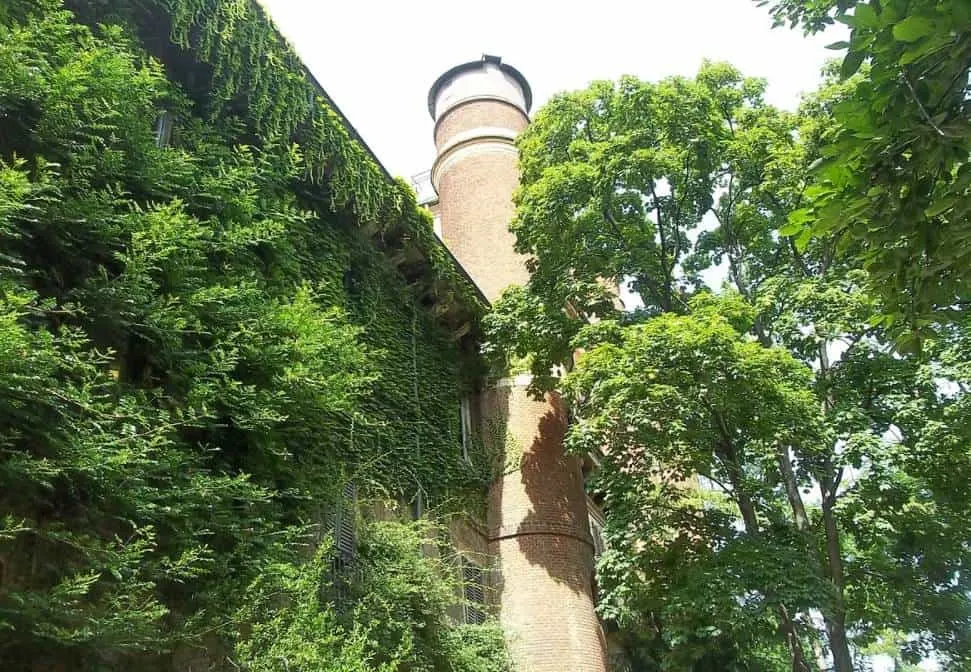
35. Palazzo Castiglioni
There isn’t a shortage of amazing palaces in Milan, that’s for sure. Palazzo Castiglioni in the eastern part of the city is unique, though.
The palace was constructed in the early 20th century and designed in the so-called “Liberty Style,” the Italian version of Art Nouveau.
It was named after the man who commissioned it named Ermengildo Castiglioni, a rich Milanese entrepreneur.
He hired renowned Art Nouveau architect Giuseppe Sommaruga to design it in the trendy new emerging style at the time, and what a result it was!
The family eventually sold the palace to the Union of Commerce in the 1960s and it was transformed into an office building, a purpose it still serves today.
Even though it’s not possible to enter the building, admiring the unique architecture of the building’s façade should be part of your Milan bucket list.
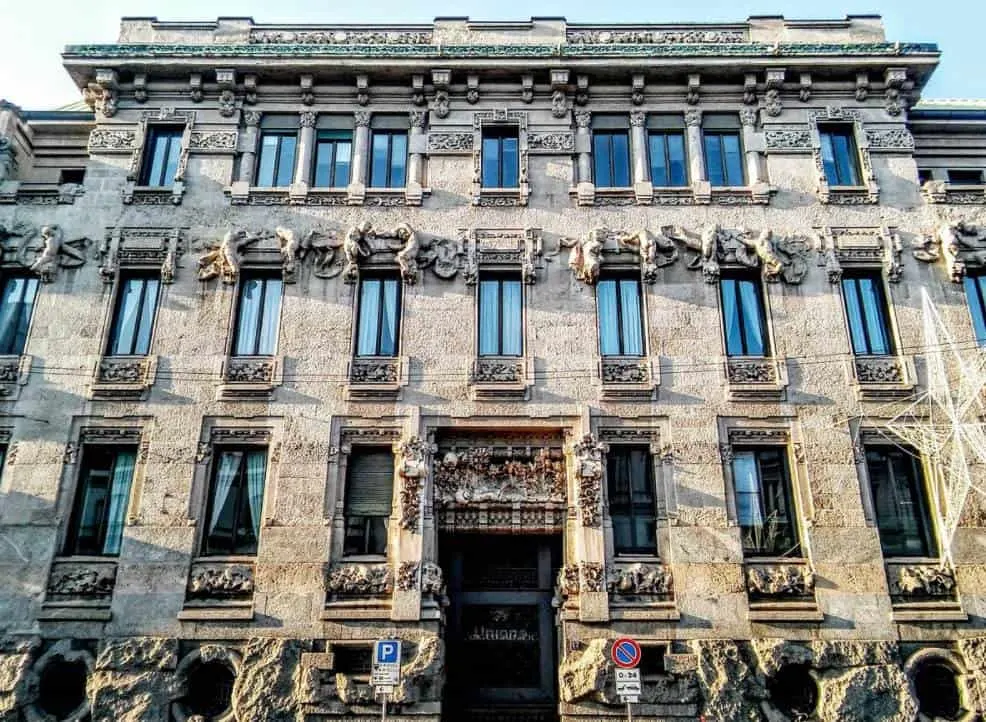
36. San Fedele
Just north of the most famous cathedral in the city, the Duomo, you can find another picturesque Jesuit church called San Fedele.
Just outside the church, there’s a bronze statue of Alessandro Manzoni (1775-1873) and the most renowned Italian writers in history.
He is world-famous for his work “The Betrothed” (1827), a work considered to be one of the ultimate masterpieces written in the Italian language. He died at a very old age after falling from the steps of this church while leaving the mass he was attending.
The church was built in the 16th century but several elements of it date back to the following centuries.
The main attraction of the church is the “Museo San Fedele” which holds a surprising collection of Jesuit relics dating back to the 14th century.
Guided tours are available as well to learn everything about the crypt, the sacristy, and the relics and paintings on display in the museum.
Official website: Museo San Fedele
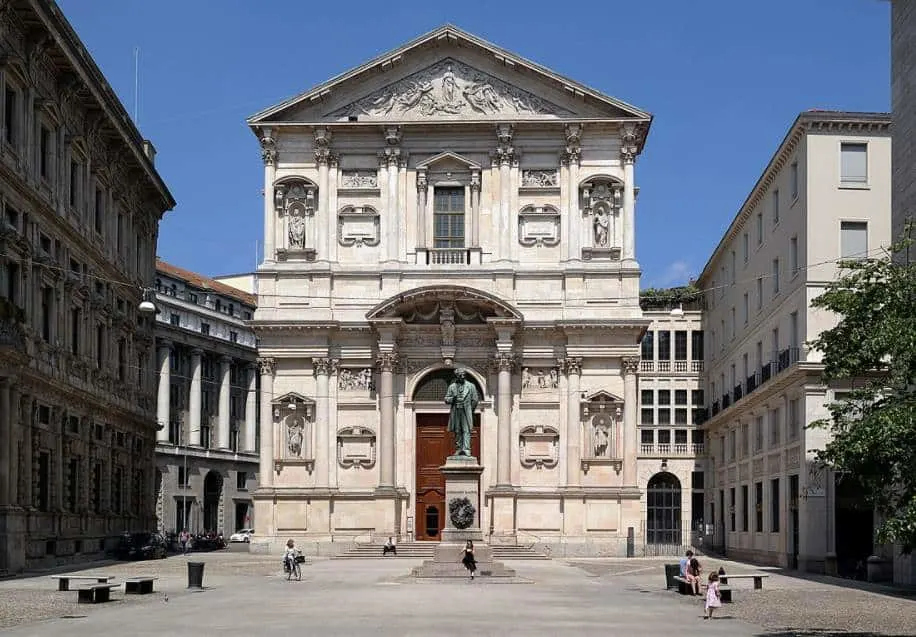
37. Milan’s 4 house museums
The “Case Museo di Milano” is a collection of 4 house museums that you can visit in the city. All of these have their particular style and feature numerous works of fine art.
The 4 museums are:
- The Bagatti Valsecchi Museum – The house of two 19th century barons named Fausto and Giuseppe Bagatti Valsecchi.
- The Boschi di Stefano Museum – The historical residence of di Stefano which features over 300 works of art.
- The Villa Necchi Campiglio – An architectural masterpiece in the center of Milan.
- The Poldi Pezzoli Museum – A house featuring the art collection of Milanese aristocrat Gian Giacomo Poldi Pezzoli (1822-1879).
House museums give you an intimate look into the lives of their owners which your visit a remarkable experience.
Official website: Casa Museo Boschi di Stefano

38. Gae Aulenti Square
Even though the historical buildings make up most of the attractions in Milan, the city also has a fast-growing modern section that has remarkable architectural features.
The epitome of this modern section in the city is a futuristic square called the “Piazza Gae Aulenti” or “Gae Aulenti Square.”
The amazing square was named after Gae Aulenti (1927-2012), the renowned Italian architect who is known for transforming historic buildings into unique structures.
She’s especially known for her work on popular museums, including the Musée d’Orsay and the Contemporary Art Gallery of the Centre Pompidou in Paris.
The modern square is located right across the “Garibaldi Train Station,” Milan’s main transportation hub.
The square was constructed around a huge reflecting pool that has a diameter of 60 meters (196 feet) and is surrounded by modern skyscrapers, quite an amazing place to hang out.

39. Basilica of Sant’Eustorgio
Another very old structure in the city of Milan is located in the southern part of the city and is named the Basilica of Sant’Eustorgio.
It was named after Eustorgius I, a man who was the bishop of Milan between 343 and 349. This also means that the church was founded way back in the 4th century, shortly after Christianity became the official religion in the Roman Empire.
The original church was completely rebuilt in the Romanesque style in the 12th century, and the final architectural elements were completed 4 centuries later.
One of the most remarkable facts about this church is that it was here that pilgrims stopped in Milan while traveling to Rome of the Holy Land.
That’s because it was believed that this church housed the tomb of the “Three Magi,” commonly known as the Three Kings.
After an absence of nearly 800 years, parts of these relics were sent back to Milan from Cologne in the early 20th century and are now kept near the so-called “Three Kings Altar” in the church.
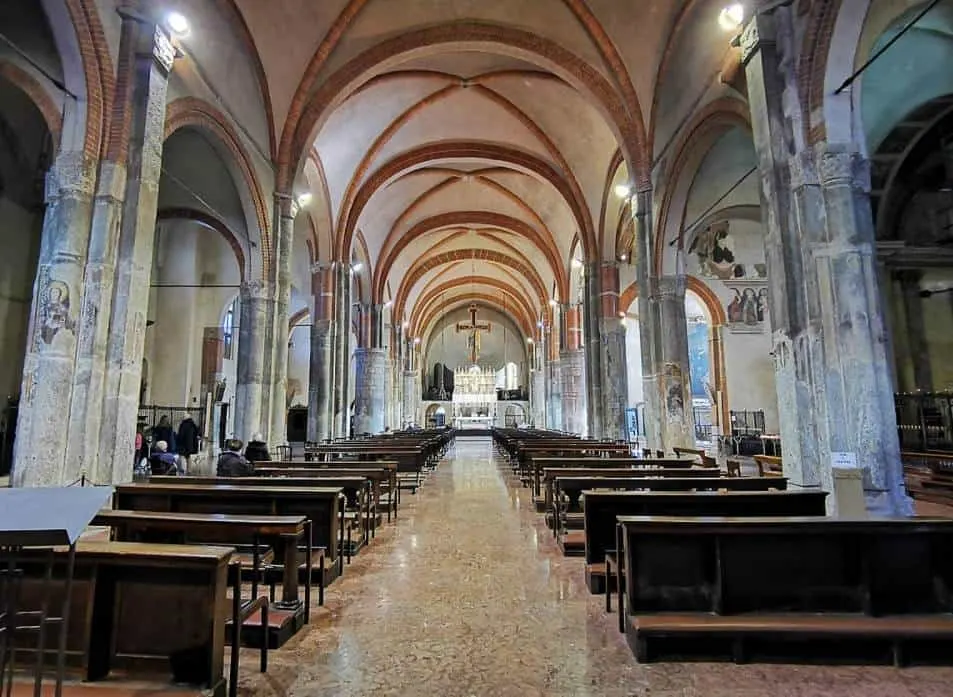
40. Corso Buenos Aires
If you want to shop until you drop in Milan, then there’s good news, you definitely can!
You don’t even need to leave a single street because the “Corso Bueno Aires” provides all the clothing stores you need.
This major shopping street in the northeastern part of the city features over 350 clothing stores, the highest concentration of any street in Europe.
The street is especially popular among locals, and even though you won’t find any of the exclusive brands, it’s considered to be the busiest street in Milan.
The Corso Buenos Aires is lined with buildings constructed in the neoclassical and Art Nouveau architectural styles with most of the buildings dating back to the 19th and 20th centuries.
The street is about 1.2 kilometers (0.74 miles) long and starts in the Porta Venezia Neighborhood. It ends in a major square known as the Piazzale Loreto.
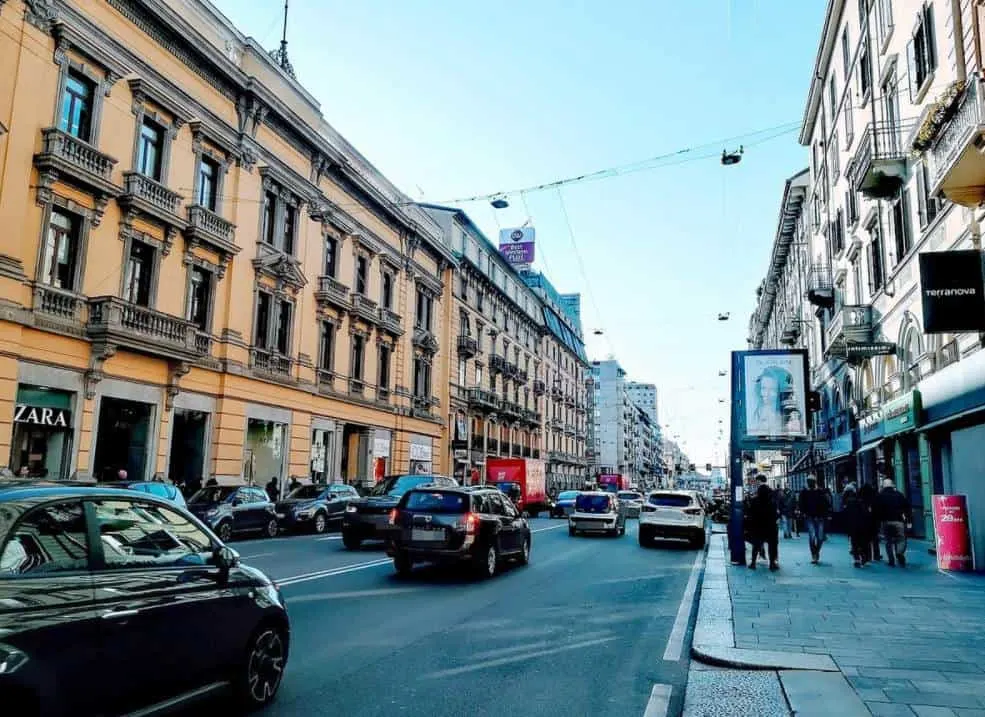
41. San Bernardino alle Ossa
San Bernardino alle Ossa is a church located just east of the famous Cathedral of Milan, but the church itself isn’t the main attraction.
The fascinating feature of the church is a side chapel that is defined as an ossuary. This means that the walls of this chapel are decorated with human skulls and bones.
A cemetery was located on this location in the 12th century, but when it ran out of space, a building was constructed in 1210 to house its bones.
The church was built right next to this chamber and was completely renovated in 1679. During this phase, the side chapel of the church was turned into an ossuary as its walls were decorated with these bones and skulls.
Even though the church was destroyed in 1712, it was rebuilt shortly after at a much larger scale, mainly because of the popularity of the ossuary.
It’s hard to deny that this is one of the most peculiar attractions in the city!
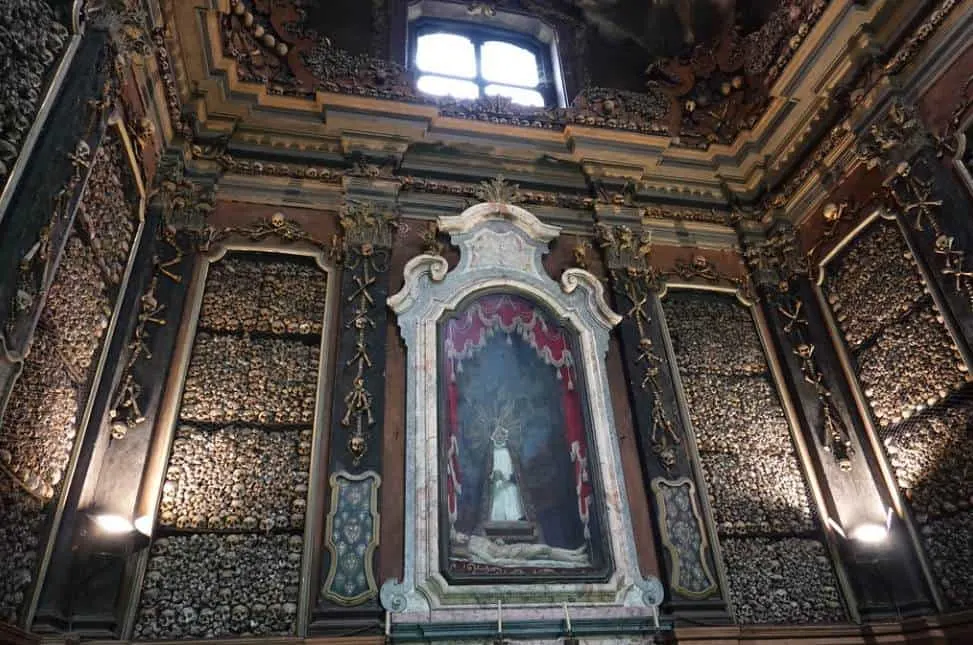
42. Civico Planetario Ulrico Hoepli
The planetarium in Milan is officially known as the “Civico Planetario Ulrico Hoepli,” a reference to the man who donated the structure to the city.
It was established in the year 1930 and is located in the Porta Venezia district of Milan. It has been operational ever since and is a popular tourist attraction with over 100,000 yearly visitors.
The structure was designed with an octagonal base that has a diameter of 19.6 meters (64.3 feet). The screen takes on the shape of a dome and the auditorium has a capacity of 300 seats.
You don’t need to be a huge astronomy fan to enjoy a visit to this amazing planetarium.
Official website: Planetario (in Italian)

43. Piazza della Scala
One of the most picturesque squares in the city has the same name as the famous building that faces it, the Teatro alla Scala opera house.
Both the square and opera house was named after a 14th-century church that was once located here named “Santa Maria della Scala.”
This charming square is connected to the Piazza del Duomo, the city’s main square, by the Galleria Vittorio Emanuele II, the famous historic shopping mall.
Leonardo da Vinci spent quite some time in Milan under the patronage of Duke Ludovico Sforza in the late 15th century, so a statue in his honor was erected for him on this square.
The statue was sculpted by Italian sculptor Pietro Magni in 1872 and dominates the rather small square. Leonardo would have been proud of this creation, we’re pretty sure of that.

44. Museo Nazionale della Scienza e della Tecnologia Leonardo da Vinci
While Leonardo da Vinci has a museum dedicated to his inventions alone, a much larger museum was named in his honor.
And what other type of museum could it be than one dedicated to science and technology, right?
The Museo Nazionale della Scienza e della Tecnologia Leonardo da Vinci is the largest of its kind in Italy and was established in the year 1953.
It’s housed in a former monastery just to the west of the city’s center and is divided into 7 departments with laboratories, making it especially interesting for kids and students.
Planes, trains, ships, and submarines are all part of the amazing collection of the museum.
As you surely expected, there’s also a section specially dedicated to da Vinci which features replicas of a number of his inventions.
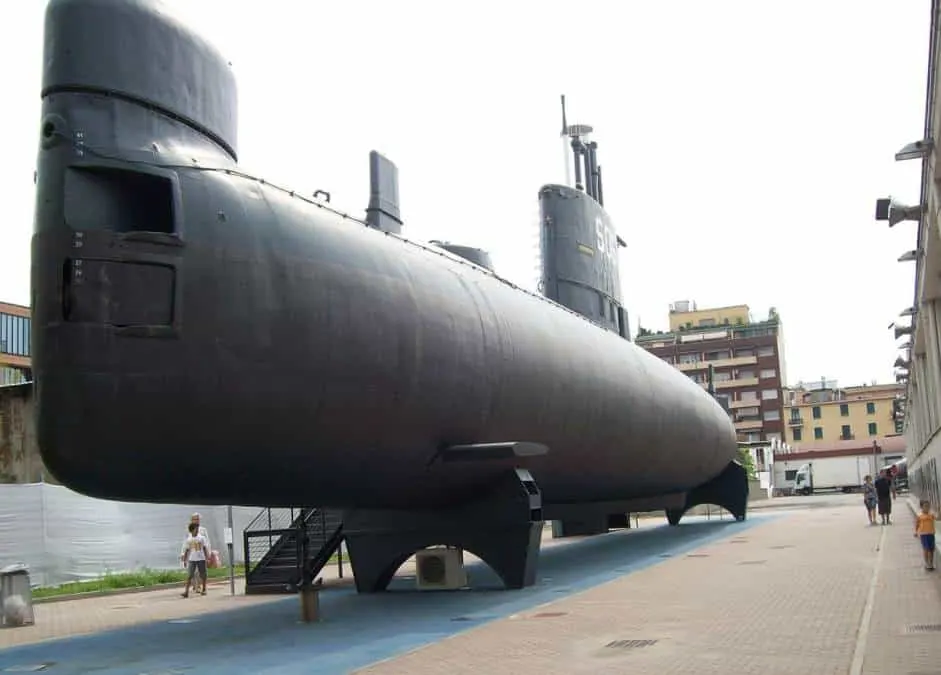
45. Admire the trompe-l’œil at Santa Maria presso San Satiro
The Renaissance-style church known as Santa Maria Presso San Satiro was built between 1476 and 1482.
It was built on a much older shrine dating back to the year 879 and was dedicated to Saint Satyrus, the brother of Saint Ambrose, the patron saint of Milan who lived in the 4th century.
When constructing the church just southwest of the main cathedral of Milan, the engineers found themselves in a bit of a pickle. The problem was a lack of space to complete the apse at the end of the structure.
Donate Bramante, one of the most renowned architects of the Renaissance, found a solution for this problem, namely a trompe-l’œil.
While the gilded interior of the church makes it worthwhile to enter, the feature you’ll come across at the choir is quite fascinating.
Even though there’s only a depth of about 90 centimeters (3 feet) available, it appears to be much bigger. That’s because of this remarkable feature painted on the wall which means an “optical illusion.”
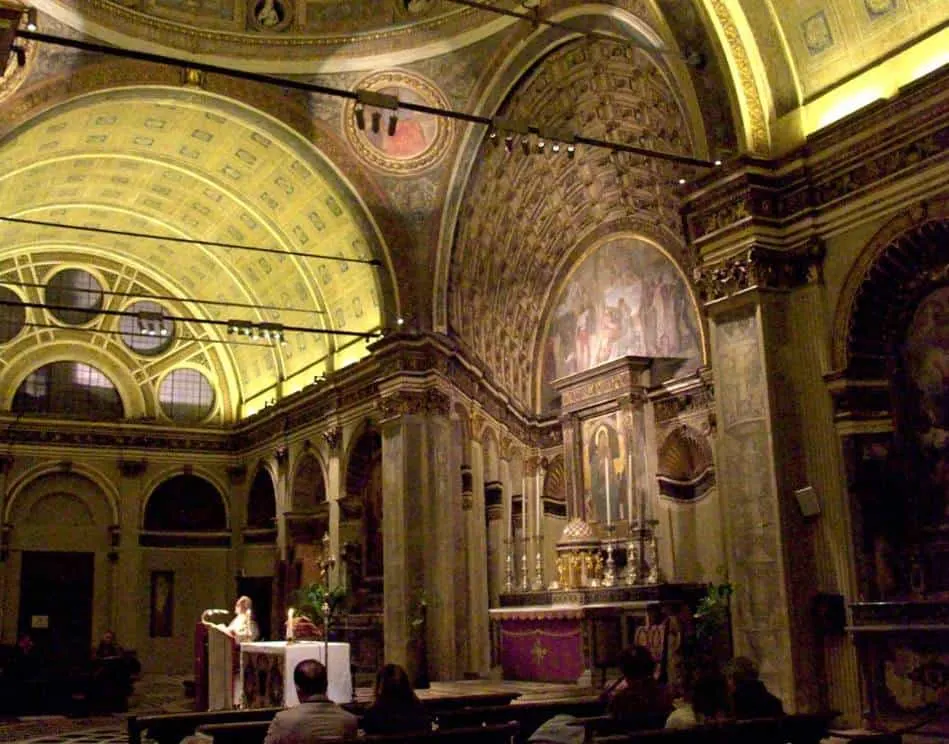
46. Gallerie d’Italia
The Gallerie d’Italia is the common name of the art gallery known as the Gallerie di Piazza Scala, and as its name implies, it’s located at the Piazza della Scala in the heart of the city.
One section of the gallery has nearly 200 works on display including numerous masterpieces of 19th-century sculptors and painters.
Another section, located in the historic building known as the “Palazzo della Banca” features 189 works of art from the 20th century.
Highlights of the museum are works by Antonio Canova and Umberto Boccioni, both considered to be some of the most influential Italian artists in history.
Official website: Gallerie d’Italia

47. Piazza Mercanti
Even though the Piazza del Duomo is considered to be the center of the city today, this wasn’t always the case. During the Middle Ages, this honor was reserved for Piazza Mercanti.
Granted, both squares are located pretty much next to each other, but the design of the medieval square has changed quite a bit over the centuries.
In medieval times, the square was known as “Piazza del Broletto,” a reference to the palace named “Broletto Nuovo” that dominated the square back then.
The square could be accessed from 6 sides in the 13th century, each entry point reserved for members of a particular trade.
The Broletto Palace was completed in 1233 and served as the administrative center of the city back then. It still faces the square on the north side, giving this place a particular medieval feeling.
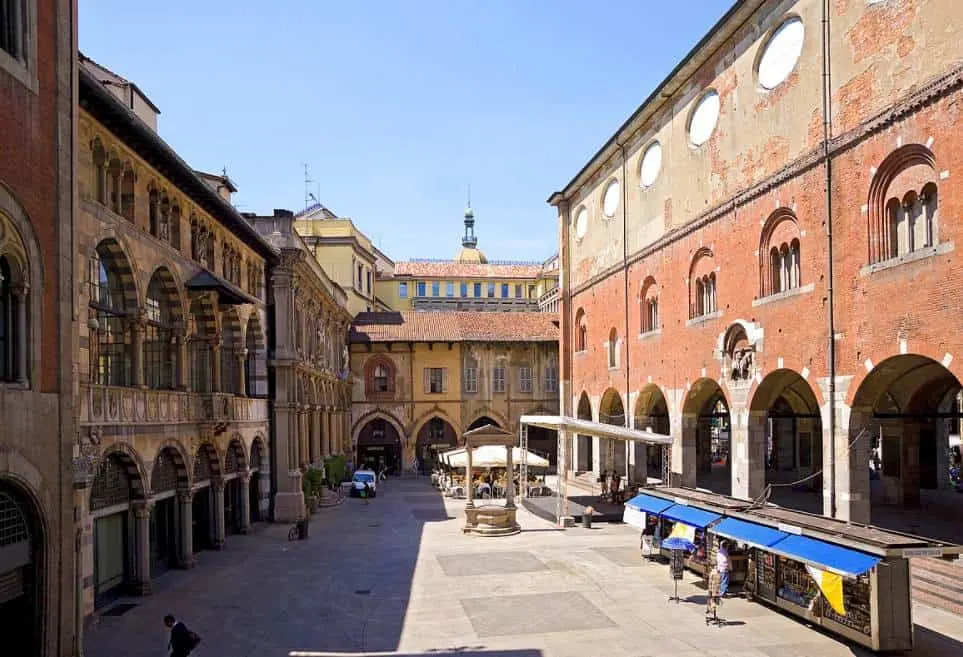
48. Natural History Museum
Even though the natural history museum in the city of Milan was established in 1838, it has only been housed in its current location since the late 19th century.
The Romanesque Revival building features Gothic elements as well and was completed between 1888 and 1893. It’s located just east of the city center near Porta Venezia in a green space known as the Indro Montanelli Garden
The museum features 5 different departments for you to explore, including Mineralogy, Paleontology, human history, Invertebrate Zoology, and Vertebrate Zoology.
The most notable features are over 100 dioramas, the largest collection in Italy, and fossils of a wide variety of Dinosaurs.
Official website: Natural History Museum (in Italian)
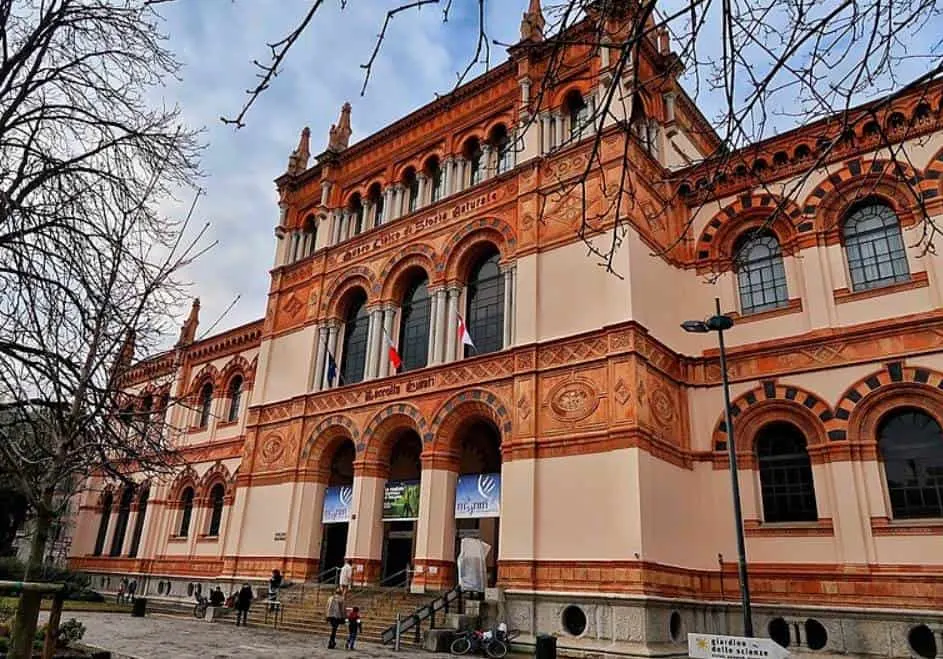
49. Royal Palace of Monza
The Royal Palace of Monza is also sometimes referred to as the “Royal Villa” or “Villa Reale.” It’s another attraction located just outside of the city proper in the suburb of Monza in the northeast of Milan’s metropolitan area.
If you do manage to travel there, make sure to check out this astounding palace as it’s nothing short of spectacular.
Situated in the immense Monza Park, the neoclassical palace dates back to Habsburg rule in Milan in the 18th century.
A renovation project of the palace started in 2012 and it’s possible today to visit the royal apartments of Umberto I and Margherita di Savoia which they used in the 19th century.
The palace in combination with the 1790 Orangerie and extensive gardens make this an excellent attraction to spend the day.
Official website: Reggia di Monza
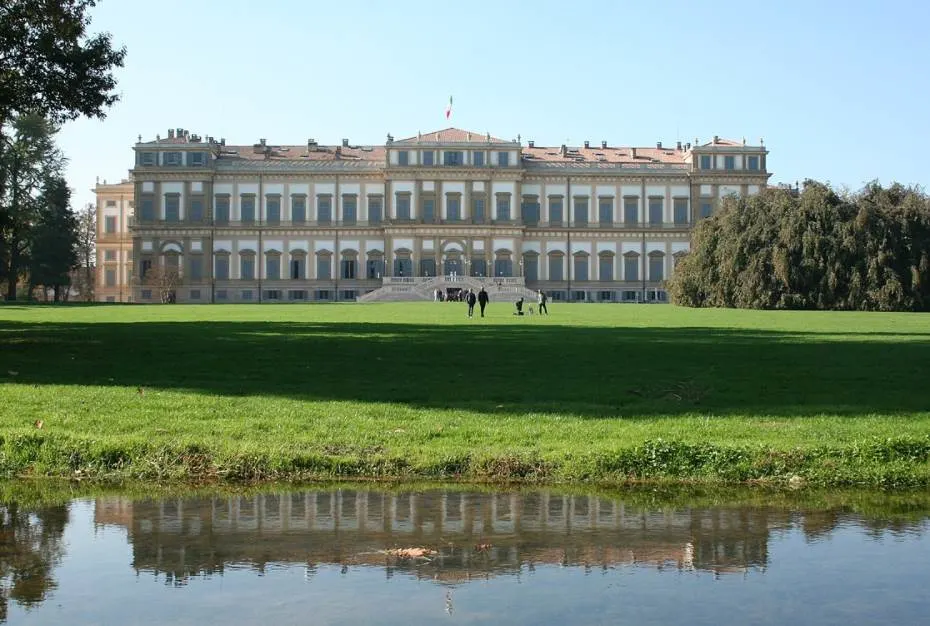
50. Terrazza Sul Duomo
Did you know that can access the roof of Milan Cathedral?
This attraction is known as the “Terrazza Sul Duomo” and as the name implies, it allows you to visit the rooftop terrace of the cathedral.
Here you can explore the magnificent sculptures that decorate the spires of the cathedral up close and get amazing views of the city as well.
You have the option to take an elevator to the top or climb the stairs as well. Regardless of which option you choose, you’ll end up having a great time on top of the most famous landmark in the city.
Official website: Visit Milan Cathedral

